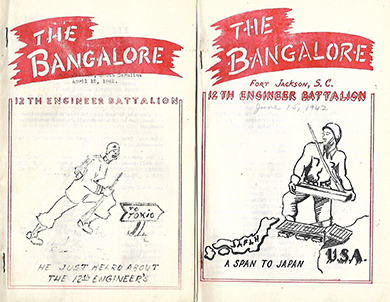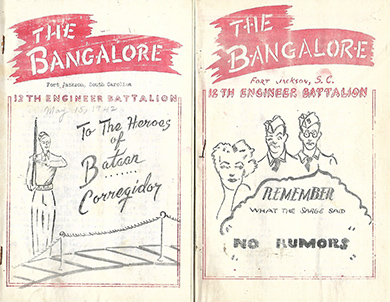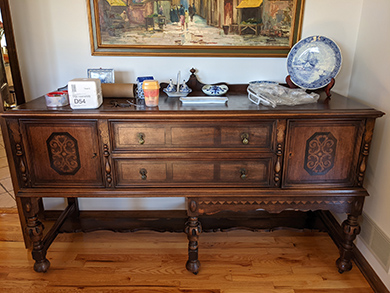 |
|
|||
 |
 |
|||
RINKER ON COLLECTIBLES — Column #1791 Copyright © Harry Rinker, LLC 2021 Questions
and Answers
QUESTION: I have five issues of “The Bangalore,” an eight-page, mimeographed newsletter of the 12th Engineer Battalion that trained at Fort Jackson, South Carolina. Three of the newsletters are dated April, May, and June 1942. Each features a cartoon sketch cover. The June issue shows an engineer building “A Span to Japan,” a pontoon bridge from the U.S.A. to Japan. The May issue shows a soldier standing at arms in front of a bridge with the text: “To The Heroes of Bataan…Corregidor.” These belonged to my father-in-law. Do they have any value? – SD, Lansdale, PA, Email Question 
ANSWER: The 12th Engineer Battalion was activated on July 1, 1940, at Fort Jackson, South Carolina. It was assigned to the 8th Infantry Division. Initially, it was comprised of individuals from the 1st Engineers stationed at Fort DuPont, Delaware, and the 7th Engineers station at Ft. Custer, Michigan. The remainder of the unit was filled with selected volunteers and the Selective Service. The 12th Engineer Battalion was initially commanded by Major Patrick H. Tansey. Major Charles H. Mason replaced Tansey in August 1941 and gave way to Major Edmund Fry in August 1942. When Major Fry was sent to Engineer School in February 1943, Major James C. Taylor assumed command. Major Fry returned to lead the 12th Engineer Battalion through its European tour of duty. Completing its training at Fort Jackson, the 12th Engineers subsequently moved to Camp Forest, Tennessee and Fort Leonard Wood, Missouri. From there, they built the Laguna Desert Camp in Arizona, Although the newsletters suggest the 12th Engineer Battalion was preparing for the Pacific campaign, it was deployed to the European Theater in July 1944. It participated in the landing at Omaha Beach on D-Day. Following D-Day, the 12th Engineer Battalion participated in the Normandy, Northern France, Rhineland, and Central Europe and Luxembourg campaigns. After World War II, the 12th Engineer Battalion was inactivated on October 25, 1945 at Fort Leonard Wood, Missouri. It was reactivated as part of the 8th Infantry Division on August 17, 1960 at Fort Jackson, SC. It moved to Nuremberg, Germany with the 8th Infantry Division in October 1956. The company eventually relocated to Dexheim, Germany. I was not able to locate a U.S. Army military museum for either the 12th Engineer Battalion or 8th Infantry Division. If you are open to donating the copies of the newsletters, I recommend contacting the librarian at the U.S. Military Academy at West Point. If the library is not interested, the librarian should be able to recommend an appropriate military museum for them. The United States Army Basic Combat Training Museum (4442 Jackson Blvd, Columbia, SC 29209 / (803) 751-7419) is located at Fort Jackson, South Carolina. As I write this column in May 2021, the museum is closed due to Covid-19. A quick call will show whether this museum has any interest. I also was unable to locate a 12th Engineer or 8th Infantry Division reenactment group, another logical place to find a home for your newsletters. Re-enactors love to include this type of ephemera in their reenactment kits. Under no circumstances should you throw these newsletters out. If you place them on eBay with an opening bid of $0.00, someone will buy them. As suggested above, I would rather see them go to a museum or other institution who will preserve them. If there are any historians of the 12th Engineer or 8th Infantry Division who will to preserve them, email me at harrylrinker@aol.com so that I can pass along your contact information to the owner. 
QUESTION: My father was in the sound business. In cleaning out his place, I found a number of items including an old loudspeaker. It has no markings on it. Can you identify the maker and provide a value? – CJ, CT, Email Question 
ANSWER: I was not able to identify the maker of your loudspeaker. I checked numerous internet sites including hundreds of images on WorthPoint.com. The base mount for the speaker is what has me confused. I wonder if it was added later by your father to turn the loudspeaker into a floor model rather than a model that sat atop an old battery-operated radio. There is no doubt the speaker is a radio bell horn speaker and dates from the 1910s or 1920s. There were multiple companies that made such speakers. Atwater-Kent, Bristol Autophone, Dicto-Grand, Federal, Jewett, Magnavox, RCA Radiola, Silvertone, Stewart-Warner, Thompson, and Trimm are just a few examples. Manufacturer information was usually found on a metal plaque attached to the base mount of the speaker. The Bristol Autophone, a version of the Dicto-Grand, RCA Radiola, Stewart-Warner, and Trimm loudspeakers closely resemble the example that you have. The similarity in loudspeaker design suggests the possibility that some radio manufacturers contracted with loudspeaker manufacturers who then branded the loudspeakers with the brands of their clients. Bell size (the larger the better), material (brass, painted tin, or wood), completeness (period mount), and working order impact value. Radio loudspeakers with their period base in very good or better condition and in working order regularly sell for over $100.00. If your speaker with its “replacement base” works, its value is between $50.00 and $60.00. QUESTION: I have a Baker dining room china cabinet and large buffet. The drawer of the buffet is marked “Shop /BAKER / ALLEGAN, MICH / Mark” in an octagon. The china cabinet is marked “H. P. Co. “4 1824.” The dining room set also contains a large buffet with a Paine Furniture Company label. Using the images that accompanied my email, can you provide information as to the age and value of my Baker furniture? – AF, Email Question 
ANSWER: Your dining room furniture is a harlequin set, meaning it consists of pieces from several different manufacturers. Such sets were common in the 1920s and 1930s when individuals purchased furniture from large furniture stores that offered furniture from a variety of makers. Many individuals chose to mix and match. Your two Baker pieces are confusing because they have different maker marks. However, they are a perfect match in terms of their stylistic design elements. They obviously were meant to be sold as a set, possibly with other matching pieces that you do not have. The style is 1920s/1930s Colonial Revival. The pieces contain design elements from a variety of earlier period styles with a “Spanish” theme being the most prevalent. Note the large buffet is missing its apron on the left side. Siebo Baker, an immigrant from the Netherlands, founded an interior woodworking and door company in 1890 in Allegan, Michigan. Three years later, Baker made its first piece of furniture, a combination bookcase and desk. In 1910, Siebo’s son Hollis graduated from the University of Michigan and joined the Baker Furniture as a salesman. Hollis would eventually succeed his father. In the mid-1920s, Baker Furniture had achieved a national reputation for design and quality. In 1925, Baker Furniture introduced a Modernist furniture line designed by Donald Deskey. In addition, it continued to manufacture furniture in multiple Colonial Revival styles. According to WorthPoint.com, Baker used the octagonal mark from 1927 to 1935. Your piece appears to have an early version of the mark. I could find no reference to Baker using an “H. P. Co.” mark. Perhaps, it is a store brand for pieces Baker made exclusively for the store. Your furniture is known in the antiques and collectibles trade as “brown goods,” a type of furniture that has fallen on hard times in today’s secondary market. While there are rumors that younger buyers are starting to become interested in Colonial Revival pieces, especially in large urban markets, I have found no field evidence to support this. The secondary market value of your Baker china cabinet and buffet is between $100.00 and $125.00. This price reflects the fact that a portion of the apron is missing on the buffet. 
Harry L. Rinker welcomes questions from readers about
collectibles, those mass-produced items from the twentieth and twenty-first centuries.
Selected letters will be answered in this column.
Harry cannot provide personal answers.
Photos and other material submitted cannot be
returned.
Send your questions to: Rinker on Collectibles, 5955 Mill
Point Court SE, Kentwood, MI 49512.
You also can e-mail your questions to
harrylrinker@aol.com.
Only e-mails containing a full name and mailing address
will be considered.
|
||||